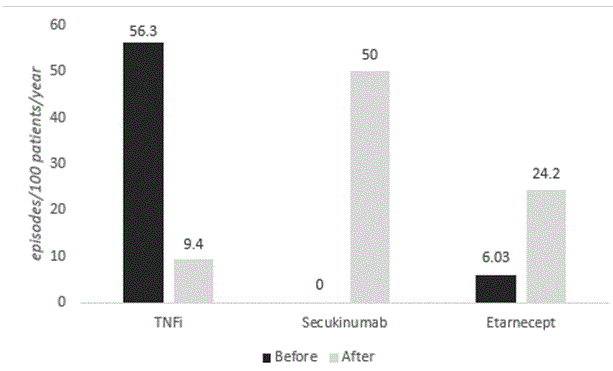Back
Poster Session C
Spondyloarthritis (SpA) including psoriatic arthritis (PsA)
Session: (1150–1165) Spondyloarthritis Including PsA – Basic Science Poster
1159: Uveitis in Psoriatic Arthritis: Study of 406 Patients in a Single University Center
Sunday, November 13, 2022
1:00 PM – 3:00 PM Eastern Time
Location: Virtual Poster Hall
- Ad
Ana de Vicente Delmás, MD
Hospital General Santa María Del Puerto
Sevilla, Spain
Abstract Poster Presenter(s)
Ana De Vicente-Delmás1, Lara Sánchez-Bilbao2, Vanesa Calvo Río3, David Martínez-López2, Alba Herrero-Morant4, Eva Galíndez-Agirregoikoa5, Nuria Barroso-García6, Natalia Palmou-Fontana2, Miguel Ángel González-Gay7 and Ricardo Blanco8, 1Hospital General Santa María del Puerto, Cádiz, Spain, 2Hospital Universitario Marqués de Valdecilla, Santander, Spain, 3Valdecilla Hospital, Santander, Spain, 4Hospital Universitario Marqués de Valdecilla, Ontinyent, Spain, 5Basurto University Hospital, Bilbao, Spain, 6Hospital Universitario Puerta del Mar, Cádiz, Spain, Cádiz, Spain, 7Department of Medicine and Psychiatry, Universidad de Cantabria; Rheumatology Division, Hospital Universitario Marqués de Valdecilla; Research group on genetic epidemiology and atherosclerosis in systemic diseases and in metabolic diseases of the musculoskeletal system, IDIVAL, Santander, Spain. Cardiovascular Pathophysiology and Genomics Research Unit, School of Physiology, Faculty of Health Sciences, University of the Witwatersrand, Johannesburg, South Africa, 8Hospital Universitario Marqués de Valdecilla, IDIVAL, Santander, Spain
Background/Purpose: The manifestations of uveitis are well-established in Axial Spondyloarthritis (ax-SpA), but not in Psoriatic Arthritis (PsA). We aimed to assess, in a large unselected series of PsA: a) the frequency and clinical features of uveitis; b) its association with PsA activity, the impact of disease and functional disability, and, c) its relationship with the biologic treatment. Besides, a literature review was performed.
Methods: Cross-sectional study of PsA patients from a single referral hospital. PsA was classified according to the CASPAR criteria, and uveitis was diagnosed by experienced ophthalmologists.
Results: We studied 406 patients with PsA (46.3±12.3 years). Uveitis was observed in 20 (4.9%). Uveitis was acute in all cases, anterior (80%), unilateral (80%) and recurrent (50%). Patients with uveitis had a higher prevalence of HLA-B27 (45% vs 7.5%, p< 0.0001), sacroiliitis on MRI (25% vs 8.3% p=0.027), ocular surface pathology (10% vs 0.8%, p=0.021), and median PsAID (5.9 [2.1-6.8] vs 1.25[0.0-3.0], p=0.001) and BASFI (4 [1.6-5] vs 1.0 [0.0-3.5], p=0.01).The general features of patients and the comparison between patients with and without uveitis is shown in the Table.The incidence (episodes/100 patients-year) of uveitis before versus after biologic treatment decreased with anti-TNFα monoclonal antibodies (56.3 vs 9.4) and increased with etanercept (ETN) (6.03 vs 24.2) and secukinumab (SECU) (0 vs 50) (Figure).
Conclusion: The prevalence of uveitis in patients with PsA was about 5%. The pattern was similar to that observed in ax-SpA. Uveitis was associated with a greater impact of the disease and greater functional disability. The uveitis rate decreased with anti-TNFα monoclonal antibodies and increased with ETN and SECU.
.gif) Table. General features of 406 patients with Psoriatic Arthritis. Comparison between patients with and without uveitis.
Table. General features of 406 patients with Psoriatic Arthritis. Comparison between patients with and without uveitis.
 Figure. Uveitis incidence rate before and after biological therapy.
Figure. Uveitis incidence rate before and after biological therapy.
Disclosures: A. De Vicente-Delmás, None; L. Sánchez-Bilbao, Eli Lilly; V. Calvo Río, AbbVie/Abbott, Eli Lilly, Merck/MSD, UCB; D. Martínez-López, None; A. Herrero-Morant, None; E. Galíndez-Agirregoikoa, None; N. Barroso-García, None; N. Palmou-Fontana, None; M. González-Gay, AbbVie/Abbott, Merck/MSD, Janssen, Roche, AbbVie/Abbott, Roche, Sanofi, Eli Lilly, Celgene, Sobi, Merck/MSD; R. Blanco, Eli Lilly, Pfizer, Roche, Janssen, MSD, AbbVie, Amgen, AstraZeneca, Bristol Myers Squibb, Galapagos, Novartis, Sanofi.
Background/Purpose: The manifestations of uveitis are well-established in Axial Spondyloarthritis (ax-SpA), but not in Psoriatic Arthritis (PsA). We aimed to assess, in a large unselected series of PsA: a) the frequency and clinical features of uveitis; b) its association with PsA activity, the impact of disease and functional disability, and, c) its relationship with the biologic treatment. Besides, a literature review was performed.
Methods: Cross-sectional study of PsA patients from a single referral hospital. PsA was classified according to the CASPAR criteria, and uveitis was diagnosed by experienced ophthalmologists.
Results: We studied 406 patients with PsA (46.3±12.3 years). Uveitis was observed in 20 (4.9%). Uveitis was acute in all cases, anterior (80%), unilateral (80%) and recurrent (50%). Patients with uveitis had a higher prevalence of HLA-B27 (45% vs 7.5%, p< 0.0001), sacroiliitis on MRI (25% vs 8.3% p=0.027), ocular surface pathology (10% vs 0.8%, p=0.021), and median PsAID (5.9 [2.1-6.8] vs 1.25[0.0-3.0], p=0.001) and BASFI (4 [1.6-5] vs 1.0 [0.0-3.5], p=0.01).The general features of patients and the comparison between patients with and without uveitis is shown in the Table.The incidence (episodes/100 patients-year) of uveitis before versus after biologic treatment decreased with anti-TNFα monoclonal antibodies (56.3 vs 9.4) and increased with etanercept (ETN) (6.03 vs 24.2) and secukinumab (SECU) (0 vs 50) (Figure).
Conclusion: The prevalence of uveitis in patients with PsA was about 5%. The pattern was similar to that observed in ax-SpA. Uveitis was associated with a greater impact of the disease and greater functional disability. The uveitis rate decreased with anti-TNFα monoclonal antibodies and increased with ETN and SECU.
.gif) Table. General features of 406 patients with Psoriatic Arthritis. Comparison between patients with and without uveitis.
Table. General features of 406 patients with Psoriatic Arthritis. Comparison between patients with and without uveitis. Figure. Uveitis incidence rate before and after biological therapy.
Figure. Uveitis incidence rate before and after biological therapy.Disclosures: A. De Vicente-Delmás, None; L. Sánchez-Bilbao, Eli Lilly; V. Calvo Río, AbbVie/Abbott, Eli Lilly, Merck/MSD, UCB; D. Martínez-López, None; A. Herrero-Morant, None; E. Galíndez-Agirregoikoa, None; N. Barroso-García, None; N. Palmou-Fontana, None; M. González-Gay, AbbVie/Abbott, Merck/MSD, Janssen, Roche, AbbVie/Abbott, Roche, Sanofi, Eli Lilly, Celgene, Sobi, Merck/MSD; R. Blanco, Eli Lilly, Pfizer, Roche, Janssen, MSD, AbbVie, Amgen, AstraZeneca, Bristol Myers Squibb, Galapagos, Novartis, Sanofi.

